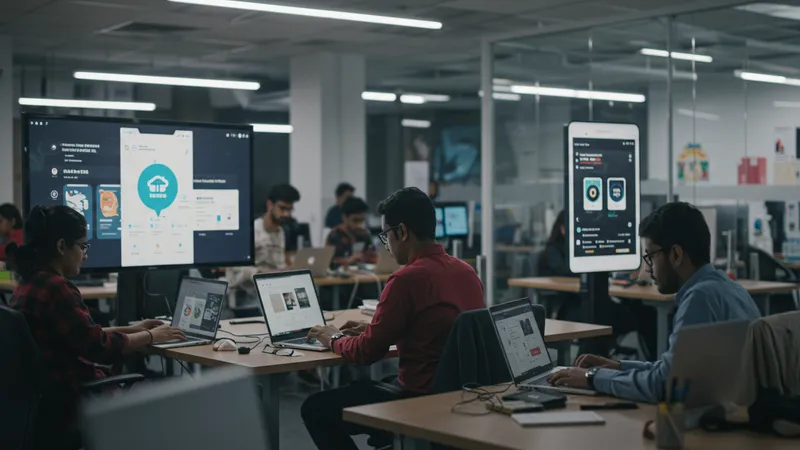

For years, building a mobile app or software solution was reserved for those with deep technical knowledge and advanced programming skills. Today, a new movement has reshaped this landscape: the rise of no-code platforms. These tools allow everyday individuals, regardless of their technical background, to design, prototype, and even launch fully functioning applications—simply by using visual interfaces and pre-built elements. The underlying magic lies in dragging, dropping, and configuring logic, rather than the traditional approach of writing extensive lines of code.
No-code platforms have become increasingly popular across India’s rapidly growing tech sector. Entrepreneurs, students, and professionals from non-programming backgrounds are now empowered to solve real business problems without hiring a team of coders. By transforming app development into a more accessible process, these platforms can accelerate innovation, reduce costs, and help ideas move straight from imagination to reality much faster than traditional software development cycles.

One core advantage of these platforms is their ability to turn complex backend processes into simple toggles or selections on a dashboard. Many Indian startups use Bubble to rapidly launch MVPs and validate user demand before investing in more advanced technology. The process is so streamlined that even those unfamiliar with technical jargon can map workflows, connect databases, and design user interfaces using only visual cues and step-by-step guidance.
Additionally, the economic efficiency is a significant draw in India’s competitive market. No-code solutions like AppGyver offer feature-rich packages for free or at affordable rates, bypassing the need for expensive software engineers in the earliest stages of product development. OutSystems, while pricier, is favored by established businesses seeking to accelerate digital transformation and automate workflows without major hiring overhead.
Many educational initiatives in India, from leading universities to online bootcamps, incorporate no-code training alongside entrepreneurship and digital skills programs. The goal is to democratize software creation, so innovators from diverse backgrounds—arts, retail, healthcare, and beyond—can tackle problems and create solutions without being hindered by technical barriers.
Importantly, no-code platforms are bridging gaps in access throughout Indian communities. Rural entrepreneurs and local governments now prototype tools, apps, and digital services faster, tangibly impacting service delivery and economic empowerment.
As Indian businesses experiment with no-code applications—from online pharmacies to logistics tracking and e-learning—the potential to disrupt traditional development models grows. However, beyond the excitement lies a set of crucial considerations, limitations, and scaling strategies. The deeper details reveal even more valuable insights ahead…
Indian enterprises seeking agility often look to no-code solutions for fast deployment and easy scalability. OutSystems, for example, has made substantial inroads among major Indian corporations tackling digital transformation across finance, insurance, and telecom sectors. These companies benefit from OutSystems’ ability to unite workflow automation and complex database management, reducing project timelines that once took months to just weeks. Meanwhile, Bubble’s flexibility caters to early-stage Indian startups aiming to quickly launch consumer-facing web applications and collect user feedback with minimal investment.

AppGyver’s arrival and its free core offering have significantly benefited India’s thriving freelance and solo-preneur scene. These professionals often operate on tight budgets and require tools that streamline app development for business ideas, online marketplaces, or community initiatives—without compromising on customization. AppGyver’s visual builder, readily available in India, makes building and deploying apps feasible even for those with no formal technical training.
Large Indian businesses face unique compliance and data localization requirements. OutSystems adapts to these, allowing secure on-premises deployments or private cloud integrations—a feature that appeals to highly regulated sectors like banking. On the other hand, Bubble and AppGyver, with their cloud-based models, are usually preferred by more agile ventures less restricted by such mandates, enabling fast deployment and continuous iteration.
The Indian government’s “Digital India” initiative has also triggered widespread digitalization at rural and urban levels. No-code tools are critical to this ecosystem, with non-government organisations leveraging Bubble or AppGyver for rapid deployment of mobile apps supporting social programs in education, healthcare registration, and resource tracking. This proves the versatility and social relevance of no-code platforms within India’s development landscape.
Opting for no-code platforms offers immense time savings for Indian users. Traditional app development, which required multi-month software projects and coding specialists, now often takes just days or weeks with no-code tools. This speeds up go-to-market strategies for startups in India’s bustling tech ecosystem, letting them validate business concepts quickly and stay ahead of their competitors.

Cost efficiency is another significant advantage, as talent shortages and developer salaries have risen in India’s metropolitan hubs. No-code allows even bootstrapped entrepreneurs to bring their vision to life without the heavy overheads of full-stack development. Because platforms like AppGyver are free for solo users, individuals and micro-enterprises can create robust apps with virtually no up-front investment—something not possible just a few years ago.
Accessibility broadens the pool of creators beyond the tech sector. Digital marketers, teachers, and nonprofit managers in India can now design custom tools tailored for their workflows or communities without engaging with code. This democratization fosters a culture of innovation and empowers local solutions to local challenges—from e-commerce shops to municipal service reporting tools.
Another unique benefit is the chance for quick iteration and experimentation. Unlike traditional builds, no-code platforms enable users to modify app features almost instantly. This rapid prototyping fits well with the Indian market’s need to adapt to fast-changing customer preferences, helping businesses remain agile in the face of evolving demands.
Despite their compelling promise, no-code platforms in India do present some limitations. While they’re ideal for rapid prototyping or small-scale apps, more advanced functionalities—such as custom integrations or highly specialized business logic—may still require traditional development methods. Enterprises often discover these constraints when scaling their no-code prototypes into production-level systems.

Security and compliance represent another big concern. Indian companies, especially those handling sensitive financial or user data, must evaluate how no-code solutions handle data privacy, hosting, and regulatory requirements. While OutSystems offers enterprise-grade features and local deployment options, cloud-based no-code platforms like Bubble or AppGyver may need careful vetting before use in sectors subject to strict Indian laws.
Vendor lock-in is a potential risk for Indian businesses embracing no-code. Transitioning away from one platform to another—or to bespoke code—is not always simple, particularly if an app becomes business-critical. Teams need to assess future maintenance and migration strategies upfront, rather than rely solely on the initial ease of use.
Skill development remains important. While coding expertise isn’t required, maximizing the possibilities of no-code platforms still demands creativity, process mapping, and an understanding of digital workflows. Many Indian educational initiatives now supplement no-code learning with broader digital literacy, ensuring citizens can effectively contribute to—and benefit from—this technology movement.
The potential of no-code platforms is poised to expand further across India’s digital economy. As infrastructure improves and more young entrepreneurs embrace technology, solutions like OutSystems, Bubble, and AppGyver are likely to see dramatic adoption in both urban and semi-urban regions. Enhanced mobile internet access will help rural innovators participate too, breaking the historical barriers of geography and technical skill.

Indian software outsourcing firms are already incorporating no-code development into their service portfolios. They use these platforms to deliver proofs-of-concept or scalable internal tools for clients worldwide, aligning with global trends while keeping project costs under control. This hybrid approach—a mix of no-code and code—may fast become the norm for India’s development services industry.
Policy support also plays a key role. The Indian government’s push for a “Digital India” and skill-building initiatives are encouraging more inclusive participation in the digital economy. No-code platforms, by making app development accessible, can accelerate social entrepreneurship and allow grassroots solutions to take root faster than ever before.
Ultimately, as India continues to digitalize and diversify its economic activity, the rise of no-code is set to transform how people from all backgrounds turn ideas into impactful apps. The true test will be how quickly both enterprises and independent creators can harness these new tools to address the country’s unique digital needs and challenges.